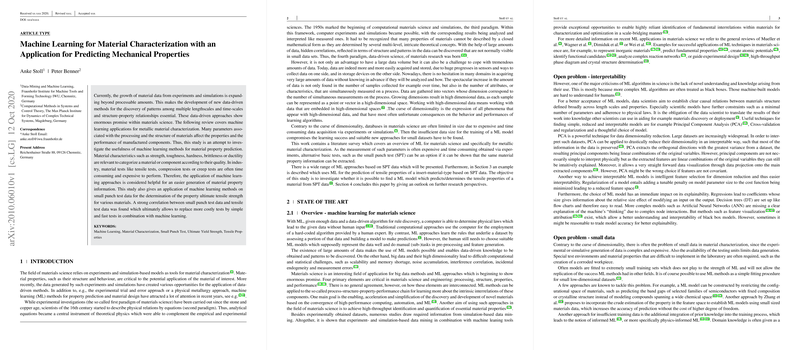Machine Learning for Predicting Mechanical Properties in Material Characterization
The paper "Machine Learning for Material Characterization with an Application for Predicting Mechanical Properties" by Anke Stoll and Peter Benner presents a detailed exploration of the application of ML strategies in the domain of materials science, focusing on the prediction of mechanical properties. The paper emphasizes the burgeoning role of data-driven methods, notably machine learning, in unearthing the non-linear relationships between the structure of materials and their properties, which traditional experimental techniques struggle to capture due to their inherent limitations.
Overview
The paper identifies the growing volume of material data generated from experiments and simulations as a compelling rationale for adopting machine learning methodologies. This data proliferation necessitates new strategies for processing and extracting meaningful insights regarding structure-property relationships across multiple length and time scales. The paper is principally concerned with metallic materials and investigates how machine learning can predict various material characteristics such as strength, toughness, and ductility.
A significant portion of the research is devoted to the examination of small punch test (SPT) data as a potential substitute for more conventional, but costly, mechanical tests like tensile tests. It argues that employing machine learning techniques on these simpler data sets can effectively estimate properties like ultimate tensile strength, thereby offering a potentially faster and more cost-effective approach to material characterization.
Machine Learning Applications in Materials Science
The authors discuss the four paradigms of material science evolution, from ancient experimental efforts to modern data-driven methods, positioning machine learning as an integral component of contemporary research. The use of machine learning in materials science offers advantages in scalability and pattern recognition, despite challenges such as high dimensionality and insufficient database sizes in some cases.
The paper highlights various ML applications, including ANN and SVM, across several domains such as corrosion detection, fatigue prediction, and yield stress estimation. The paper also sheds light on the challenges of interpretability in complex ML models and the necessity of integrating domain knowledge to enhance model reliability and acceptance.
Small Punch Test and Machine Learning
A key focus of the paper is the application of ML to SPTs, which provide a less resource-intensive means of estimating essential material properties. The paper outlines several pioneering works where machine learning has been employed in conjunction with SPT data, often augmented with simulation data such as Finite Element Method (FEM), to forecast mechanical behaviors.
Empirical Results and Methodology
The authors employ empirical correlations and machine learning models, such as linear regression and random forest models, to predict tensile properties from SPT data collected from various steels. Their findings suggest that these models can approximate the ultimate tensile strength with reasonable accuracy, thus reinforcing the potential of ML frameworks to complement or even supplant traditional mechanical testing methods in certain scenarios.
Implications and Future Directions
The implications of this research extend to both theoretical and practical domains, promoting efficiency in the resource-intensive field of materials engineering. The paper advocates for the expansion of accessible material databases to surmount the challenges posed by small datasets, thus enhancing the development and deployment of ML models.
The advancement of ML techniques, including the prospects of intelligent feature selection and model ensemble strategies, is poised to significantly influence materials discovery and characterization. The paper proposes that hybrid models could potentiate the confluence of experimental data and advanced computational methodologies, offering robust solutions for real-world applications in materials science.
In conclusion, Stoll and Benner's work underscores the transformative potential of machine learning in materials science, specifically in its ability to predict mechanical properties through less cumbersome testing processes. The research paves the way for further exploration into adaptive, data-driven methodologies that promise enhanced understanding and innovation in material characterization.
